 |
Success Stories From GenOM Project Participants
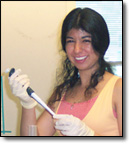
Lizzeth Belskus-Amador
High School: Interlake High School, June 2004
Currently: University of Washington Undergraduate
Department: Medicine/Allergy & Infectious Diseases, The Fred Hutchinson
Cancer Research Center
Mentor: Adam Geballe
Title: HCMV -TRS1 Mutational Analysis
Abstract: Human cytomegalovirus (HCMV) affects about 50 percent to 80 percent of the
population in the United States, but it is more prevalent in developing countries.
This virus is critical for immunocompromised patients and unborn children because
it can cause blindness, birth defects, pneumonia, coma and even death. This
virus encodes for more than 150 proteins in which TRS1 and IRS1 are said to
be in charge of preventing the shutoff of the synthesis of the proteins. The
purpose of our experiment was to find the region that binds with the double
stranded RNA during the process of synthesis. This was analyzed by using pEQ-999
which has similar genetic information as TRS1 and by creating mutations to see
what kind of proteins were produced.

Natividad Chávez
High School: Wapato High School, June 2004
Currently: University of Washington Undergraduate
Department: Radiation Biology
Mentor: Yansong Gu
Title: Study of the Origin of Chromosomal Translocations that Cause Leukemia
Abstract: Using the DNA of mice, their genotype and phenotype were determined.
This data helped determine what type of cancer and other problems the mice would
develop. PCR (polymerase chain reaction)-based genotyping methods were used
to identify mice with mutations in one or two of these genes. Understanding
the cause of the chromosomal translocations caused by drugs such as VP16 would
aid in determining why the translocations occur and what other substances would
cause the gene abnormalities and ultimately Leukemia.

Moncerrat Cisneros
High School: Toppenish High School, June 2004
Currently: University of Washington Undergraduate
Department: Radiation Oncology
Mentor: Jeffrey Schwartz
Title: Is High Radiation Sensitivity a Cause of Recurring Cancers?
Abstract: In our laboratory we are looking at whether patients who are
sensitive to the effects of radiation are more prone to second cancers later on
in their lives because of the radiation. We are testing our hypothesis using white
blood cells lines from lymphoma patients who are treated with radiation to prepare
them for a bone marrow transplant. My main project in the lab is performing experiments
and gathering data to generate growth curves on these cell lines. This is one
way of testing cells' radiation sensitivity. We studied 10 different cell lines
from 10 different patients. There was no obvious relationship between final cell
number divided by initial cell number (F/I) with any of the patient characteristics
or D50 with any of the patients characteristics. We did see an apparent relationship
between F/I and D50. Cell lines that grew faster were more sensitive to radiation.
There are clearly differences in radiation sensitivity that can be detected in
the lymphoblast cell lines. The relationship between radiation sensitivity and
growth rate needs to be further examined because of the large interexperimental
variability in the growth rates. If this hypothesis proves to be true, patients
who are sensitive to radiation could be treated with lower doses of radiation
or other types of treatments to reduce cancer risk.
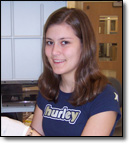
Margo Haney
High School: Skyview High School, June 2004
Currently: University of Washington Undergraduate
Department: Genome Sciences
Mentor: Carol Hopkins Sibley
Title: WR-99210 and Sulfanilamide Synergy
Abstract: An experimental drug for treating the malaria parasite, WR99210,
has been in testing for years as scientists attempt to develop methods of introduction
that reduce the likelihood of drug resistance. It has long been known that inhibitors
of the dihydrofolate synthesis and dihydropterate synthase enzymes work in synergy,
which has led to the hypothesis that WR99210 and the sulfa drug Sulfanilamide
could have synergistic effects. To test for these synergistic effects, a strain
known to be slightly resistant to WR99210 was mutated further to produce a more
resistant malaria parasite. The dihydrofolate reductase gene of this parasite
was sequenced, and the parasite was put through further drug testing to find the
optimal concentration of WR99210 it can withstand and to see if the combined effects
of WR99210 and Sulfanilamide are indeed synergistic.

Mamie Jallow
High School: Ingraham High School, June 2004
Currently: University of Washington Undergraduate
Department: Electrical Engineering
Mentor: Karl Böhringer
Title: Micro Fluidic System for Brine Shrimp Hatching Study
Abstract: Artemia salina (also known as brine shrimp or sea monkeys)
have been studied by aquacultural engineers for many years. Aquacultural engineers
studied their biomass, extension, growth and many other features. These studies
led us to build a micro fluidic channel that has the ability to study the hatching,
allowing us to control and monitor the growth and behavior of the eggs. We designed
and built acrylic micro fluidic channels and tested the micro fluidic channels'
capability of transporting individual eggs through a network of channels to
selected hatching locations.
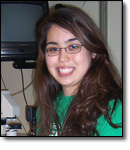
Maria K. Limon
High School: Edmonds-Woodway High School
Currently: Senior attending Edmonds-Woodway HS
Department: Biochemistry
Mentor: Stephen Hauschka
Title: The Effects of Wnt-3a and IGF-1 on Somite Myogenesis
Abstract: Somites are cells found along the neural tube of an embryo.
Myogenesis spurs from somites, which are directed into myogenesis from path
signalling proteins such as Wnt and Insulin like growth factor (IGF). Individually,
the proteins can direct the somites into myogenesis, but it is unknown if, when
combined, proteins such as Wnt and IGF will have a synergistic relation. Having
a synergistic relation would increase the amount of Myosin positive heavy chain
(MHC) cells, thus speeding up the process of muscle growth. To investigate the
relation between the two proteins, dissection of chicken embryos and immunohistochemistry was conducted.
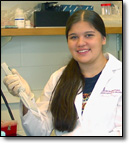
Emma Noyes (Colville)
High School: Omak High School, 2004
Currently: University of Washington Undergraduate
Department: Chemical Engineering
Mentor: Mary Lidstrom
Title: Identification of Active Populations of Microorganisms Involved
in C1 Compounds Metabolism by Stable Isotope Probing of DNA
Abstract: Active populations of microorganisms involved in C1 compound
metabolism were identified using stable isotope probing of DNA. Sediment from
Lake Washington was incubated with 13C- and 12C-labeled Methanol and Methylamine
and 13C- and 12C-labeled DNA were isolated from the sediment after centrifugation
on CsCl gradients. To identify the active microbial community, 16SrDNA were
amplified by PCR, cloned, screened by RFLP, and sequenced. The 16SrDNA from
12C and 13C Methanol experiments were closely related to Methylophilus, Pseudomonas,
Janthinobacterium, Rhodoferax and Matsuebacter. Interestingly, sequences related
to Rhodoferax and Matsuebacter (not described as C1-utilizers) were only identified
in the 13C-labeled DNA fraction, suggesting their potential implication in the
use of C1 compound in Lake Washington sediment. The future direction of this
project is to continue identifying C1-utilizers with different C1 compound substrates
and phylogenetic markers.
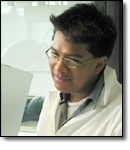
Chris Paredes
High School: Mount Tahoma High School, 2004
Currently: University of Washington Undergraduate
Department: VA Hospital
Mentor: Anton Krumm
Title: Constructing a Vector to Study Long Term Silencing
Abstract: My work over the summer was to create a vector, IRES-CD20 (internal
ribosomal entry sites), to study the effects of long term silencing, which is
what makes most gene therapies unsuccessful. To do so, I had to first create
a map of the psbc-1 vector, so I would know where to excise the IRES-CD 20 fragments.
The main problem was that some of the restriction sites (where enzymes cut)
were unknown and were later discovered to be included in the fragments that
were needed. We used a partial map, created by Wilhem Dirks, Manfred Wirth,
and Hansjorg Hauser in Dicistronic Transcription Writs for Gene Expression in
Mammalian Cells, and tested the provided sites. Then we tried other possible
restriction sites, running digests, and measuring the sample against ladders
to test our hypotheses. When we got the desired fragment, we excised it from
the gel, and purified it. That is the point we reached this summer. Hopefully,
this will clear up some of the unknown issues in boundary elements, making it
possible not only to cure cancer, but many other diseases through gene therapy.
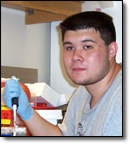
Miles Poole
High School: Bethel High School, graduation June 2005
Currently: Senior attending Bethel HS
Department: Electrical Engineering
Mentor: Deirdre Meldrum
Title: Polymerase Chain Reaction
Abstract: Follicular lymphoma is characterized by the presence of a
gene aberration in the patient genome. In this disease, a part of the chromosome
18, consisting of the bcl2 gene, is transferred to the 5' end of the chromosome
14, and it is fused with Jh gene. This translocation is defined as t (14; 18).
A PCR method to detect this translocation for the high throughput analyzer is
required. Here we describe a PCR method and it can work in two ways. After the
PCR reaction, running the reaction mixtures on agarose gel can be run to identify
the product. Alternatively, the generation of the specific product can be monitored
in real time PCR. Our real time method consists of the key reagents, Taqman_MGB
probe along with the primer for this translocation. The reaction is done in
glass capillaries with 2 L reaction mixture. Forty-eight reactions can be done
in one cassette on the MRD (minimal residual disease) analyzer. We have developed
these methods up to the stage that the translocation can be detected in the
patient DNA samples. Very stringent conditions are required to minimize the
background reaction, and yet to allow the specific reaction to proceed to detect
the presence of t (14; 18), in the bulk of the patient DNAs.

Gladys Rojas
High School: Notre Dame Academy, graduating June 2005
Currently: Senior attending Notre Dame Academy
Department: Chemistry
Mentor: Neil Dobson
Title: Transformation of DNA to RNA to Protein
Abstract: The aim of this project was to prepare 1URN, a modified version
of a protein called U1A, a component of the spliceosome. The two proteins will
be compared to see if the structures are similar. 1URN was created by Rosetta
as a modified version of U1A with the same 3-D coordinates.
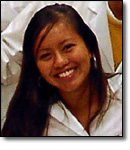
Katrina Roque
High School: Garfield High School, graduating June 2005
Currently: Senior attending Garfield HS
Department: The Fred Hutchinson Cancer Research Center, Biology
Mentor: Suzannah Rutherford
Title: Genetic Differences in Osmotic Stress Signaling and Response in
Wild Yeast
Abstract: The idea of this research project was to understand the relationship
between osmosensitivity and the strength of signaling through the osmotic stress
pathway in wild yeast cells. We developed three assays to measure yeast osmosensitivity.
KCl and sorbitol were used to cause osmotic stress. We found that a growth assay
most clearly discriminates strain differences in response to salt. Wild yeast
varied more in signaling outputs than in their response to salt, suggesting
that variation in osmotic stress signaling is buffered downstream of the transcriptional control of osmotic stress responsive genes.

M. Denise Salgado
High School: Royal High School, graduating June 2005
Currently: Senior attending Royal HS
Department: Biology
Mentor: Aimée Bakken
Title: DNA Fingerprinting: Finding Our Path Toward a Better Method
Abstract: Forensic DNA testing has been questionable to many people for
a very long time. No one is certain about whether or not a certain analysis
will give out accurate assumptions yet be quick and easy to carry out. Two methods
of DNA profiling stood out in the research findings done throughout the 2004
GenOM summer program. These methods were the VNTR methods and the PCR methods.
The two methods were put to test, research was done, and conclusions were derived
as to which one was best in order to obtain data not only faster, but also achieve
better results for DNA profiling.

Harkirat Kaur Sohi
High School: Lynnwood High School, June 2004
Currently: University of Washington Undergraduate
Department: Pathology, Genome Sciences
Mentor: Ray Monnat
Title: What DNA Target Sites can Homing Endonucleases See?
Abstract: Homing endonucleases are rare cutting enzymes that make site-specific
double strand breaks in the target DNA. Homing endonucleases also have long
recognition sequences that span 12-40 basepairs (bp). In the Monnat Lab one
of our goals is to evolve homing endonucleases to recognize new sequences of
DNA. Previous evidence has shown that homing endonucleases are able to recognize
sequences that are closely related to their native homing site. Homing endonucleases
can be evolved to recognize new sequences by combining the domain of one homing
endonuclease with the domain of another homing endonuclease. Why do we want
to evolve homing endonucleases? Why do we want them to recognize new sequences?
Many pathogens have genomes with sites that differ from homing endonuclease's
homing site by a few bp. Being able to cut the essential gene necessary for
the pathogen to survive, could kill the pathogen. Evolving homing endonucleases
can also allow us to target specific human genes to either suppress or stimulate
their expression; this can help cure certain diseases. This summer I have worked
on two separate projects with homing endonucleases: 1. H-DreI and 2. I-CreI, each project trying to address some of the above questions.
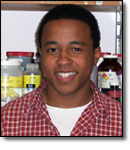
Michael J. Stennis
High School: Lakeside High School, graduating June 2005
Currently: Senior attending Lakeside HS
Department: Biology
Mentor: Aimée Bakken
Title: The Localization of Human Nucleoside Transporters in Transgenic Xenopus
laevis Frogs
Abstract: The summer of 2004 I spent at the University of Washington in the
Biology department under the guidance of Aimée Bakken studying the localization
of human nucleoside transporters in transgenic Xenopus laevis frogs. The process
of producing such frogs carrying a human gene seems virtually incomprehensible;
however, with time I was able to grasp the concept with deep understanding.
In the beginning the experiment proved to be more challenging than expected;
since it is an extensive process it is hard to identify sources of errors. All
solutions were made in the lab and many of the apparatuses used were manual.
The results found were both expected and unexpected. However, substantial conclusions
could be drawn from the results.
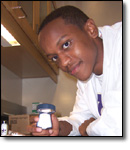
Girmay Zahilay
High School: Franklin High School, graduating June 2005
Currently: Senior attending Franklin HS
Department: Electrical Engineering
Mentor: Babak Parviz
Title: Self-Assembly as a Means for Nanofabrication
Abstract: A new method for fabricating nano-scaled machinery is described.
This method is inspired by the many exemplary building techniques in biology
and is called self assembly. Mimicking nature's ability to self-build and self-heal,
self assembly allows tiny, man made particles to assemble into certain desired
forms without actual manual contact or force. The work first involved creating
silicon wafers with micro-sized "holes" called templates. These templates
were filled with solder, and perforated in very intricately detailed patterns
across the surface. Then, four different shapes that were complimentary to the
many templates were introduced and scattered across the surface of the wafer;
by doing this, the experiment would hopefully have each specific shape unite
with its complement, and stay in place due to the interaction with the solder.
However, the lack of capillary force exerted by the solder proved to be a limiting
factor when hundreds of different shapes were randomly floating about, searching
for a stopping point that would only luckily be the correct destination. There
were results, but major scientific breakthroughs do not come overnight.
Last Reviewed: September 9, 2008
|
 |

